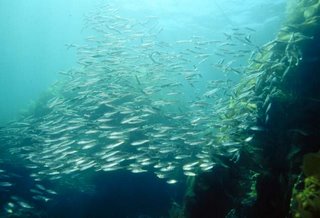

I've been curious about what sort of fish species live in the Willamette and Columbia, so I did some googling, and it's surprising how little info there is out there on the net. Most examples focus exclusively on fish of interest to recreational anglers, like
this page from the US Forest Service. You'll also come across a few sites that get all new-agey about salmon, just to spice things up a bit. I'm not going to do any salmon links, because they get plenty of attention already, and any decent search engine will find you everything you ever wanted to know, and more.
Oh, all right, here's one for ya: the site for the
Save Our Wild Salmon campaign. Just remember that they're not the only fish in the sea, ok?
I did finally come across a doc with what's currently thought to be
a comprehensive list [PDF], giving over thirty species (both native and introduced) known to live in the Willamette and its tributaries. You'd think there'd be more of a fuss about all those nonnative species in the river, but many of them are considered good fishin' and good eatin', so I guess that makes it all ok, or something. Meanwhile, we have a government-sponsored
bounty program where people are paid to catch as many Northern Pikeminnows as they can, because they prey on young salmon. They're a native fish, and they've been doing this since time immemorial, but we've decided that salmon populations can't withstand all the environmental damage we've done
and their natural predators, so obviously the predators have to go. It's only logical, right? Oh, but don't eat that pikeminnow. They're
loaded with PCBs.
More info about several of the species listed can be found on a page from the Royal BC Museum, listing
freshwater fishes of the Columbia River basin.
Here's a longer bit about
smelt, which the list calls "eulachon". Apparently that's another "common" name for the fish, although I've never heard anyone use it. When I was little, we'd sometimes go smelt dipping out on the Sandy River. I remember the river being thick with fish, and you'd just scoop your smelt net through the water, pull up a net so full you could hardly lift it, dump the contents in your bucket, and repeat until you had all you wanted. No fee, no permit, no limit, no nothin', if I recall correctly. It hardly seems sporting, which is because it's exactly the same method the Indians used to use, and they were doing it for subsistence, not for sport. And it hardly seems sustainable either. At the time (in the
supposedly environmentally enlightened 1980s, no less), everyone figured it was OK to keep doing it that way, because people assumed smelt were an inexhaustable resource. And then the population crashed in the 90's, and hasn't recovered. Gee, I wonder why?
Once you'd gotten your buckets of smelt home, it was time to clean all those oily little fish. Wherever you decided to clean 'em, the place would look and smell like a cannery in no time. And it seemed to take
forever. And the really sad part is that I didn't actually like smelt very much. They taste a lot like sardines, really fishy and oily, which is usually not a hit with the kiddies. A good portion of the catch ultimately went to waste. So I've probably earned at least some miniscule part of the blame for the fish's decline, I imagine.
The first image above is a school of smelt off the coast of California. I'm not entirely sure it's the same species that we've got here, but it's a nice picture, regardless. The second image is a
chiselmouth, one of the area's many small minnow-type fish. Mostly I liked the name. It'd be a great name for a band.
And I should at least mention sturgeon somewhere in here. They're not exactly unknown, of course. That would be impossible. They're freakin' prehistoric sea monsters. It turns out that we've actually got two sturgeon species here, and people are getting concerned about the
green sturgeon, because everybody's been ignoring it up to now, I guess because it's (relatively) smaller, and not commercially harvested. The state just
tweaked its regulations back in December, so now you aren't allowed to keep green sturgeon more than 5 feet long, down from the old limit of 5' 6". And here's a pic of
Herman II the Sturgeon, a white sturgeon and the state fish & wildlife department's mascot. Herman I used to go on road trips to the Oregon State Fair every summer, until his mysterious disappearance at the ripe age of 75 or so. People later realized that this roadtrip thing wasn't actually very good for the fish, so the fairgrounds now boast
a sculpture instead. But that's just not going to impress the kids in quite the same way, is it?
Another rather, uh, memorable aquatic creature around these parts is the
lamprey, of which our region can boast several closely related species. (In fact, they've been known to live in small streams
right here in the Portland area) Lamprey stocks are in decline too. Here's a PDF about
Pacific Lamprey conservation. Here's another, lamprey-related
conference proceedings from 2004. In general they're rather unsympathetic creatures with little to recommend them, but they're native, and they belong here. Local tribes thought, and still think, they're delicious. And hey, I'll try almost anything once, especially if it involves stepping outside cultural biases. I've only seen lampreys in person on the occasional trip up to the fish ladder at Bonneville Dam. There's a viewing area there where you can sit and watch the fish trying to go upriver, and if you're lucky (or unlucky) enough to get there when the lampreys are migrating. They often attach themselves to the
viewing window by their mouths, their bodies writhing in the current. Well, it's not something you see every day, certainly.
In the Great Lakes, there's an
ongoing invasion of nonnative sea lampreys, which are considered quite a scourge on the local lake trout. Here the situation's reversed: Lampreys are native, and lake trout are an introduced species.
Seems that PBS's Nova did a show a while back about ancient creatures of the deep, and the accompanying website lists both lampreys and sturgeon as living fossils. We seem to have a lot of "obsolete" organisms in this part of the world. We've mostly got conifer and fern forests instead of deciduous trees and flowers, and there's always the
pronghorn, which is
not an antelope. I don't know what it is. Things just don't evolve as quickly here, I guess. And don't get me started about bigfoot.
And in the "WTF" department, I ran across the website for an outfit calling itself
Lamprey Systems. I don't know quite what to make of the site, and I don't think I'm anywhere near cool enough to visit it, but I love their logo, FWIW.
tags:
oregon columbia willamette fish smelt lamprey sturgeon chiselmouth















